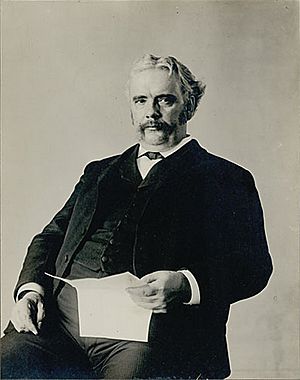William John McGee facts for kids
Quick facts for kids
William John McGee
|
|
|---|---|

McGee in 1900
|
|
| Born | April 17, 1853 Farley, Iowa, United States
|
| Died | September 4, 1912 (aged 59) Washington, DC, U.S.
|
| Nationality | American |
| Spouse(s) |
Anita Newcomb McGee
(m. 1888) |
| Children | 3 |
| Scientific career | |
| Fields | Geology, anthropology, and ethnology |
William John McGee, LL.D. (April 17, 1853 – September 4, 1912) was an American inventor, geologist, anthropologist, and ethnologist, born in Farley, Iowa.
Biography
While largely self-taught, McGee attended a rural one-room schoolhouse north of Farley during the four winter months from about 1858 to 1867. He devoted his early years to reading law and to surveying. He invented and patented several improvements on agricultural implements.
He subsequently turned his attention to geology. In 1877–1881, he executed a topographic and geological survey of 17,000 square miles (44,030 km2) in northeastern Iowa. He then undertook an examination of the loess of the Mississippi Valley, researched the great Quaternary lakes of Nevada and California and studied a recent fault movement in the middle Atlantic slope.
He was appointed geologist for the United States Geological Survey (USGS) in 1881. In 1884 McGee authored the article Map of the United States exhibiting the present status of knowledge relating to the areal distribution of geologic groups for the USGS Journal. While with the USGS, McGee travelled to Charleston, South Carolina, in 1886 for the purpose of studying the earthquake disturbances in its vicinity.
McGee was ethnologist in charge of the Bureau of American Ethnology from 1893 to 1903. In 1895, he explored the Isla del Tiburón, Gulf of California, home of the Seri Indians. In 1904 he was chief of the department of anthropology that organized the "Anthropology Days" at the 1904 Summer Olympics / Louisiana Purchase Exposition, the 1904 World's Fair. In 1907 he was appointed a member of the Inland Waterways Commission by President Roosevelt. His other prominent positions were: acting president of the American Association for the Advancement of Science (1897–1898); president of the American Anthropological Association (1902–1912); and president of the National Geographic Society (1904–1905).
McGee was also a founding member of the Geological Society of America and was the first editor of The Geological Society of America Bulletin., in 1890
Married to Anita Newcomb McGee in 1888, McGee had three children. He died in Washington, DC of cancer on September 4, 1912.
Mount McGee in California is named in his honor.
Works
His publications include:
- The Pleistocene History of Northeastern Iowa (1889)
- The Geology of Chesapeake Bay (1888)
- Primitive Trephining (1897)
- The Seri Indians (1899)
- Primitive Numbers (1901)
- Soil Erosion (1911)
- Wells and Subsoil Water (1913)

